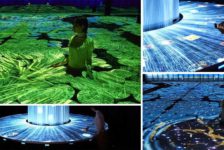At the tallest-building-of-the-world’s feet lies a park of equivalent grandiosity. Burj Khalifa skyscraper is Dubai’s highest masterpiece: at an impressive 829.8 meters (2,722 ft) tall, the tower is embraced by eleven hectares of land, which consists of a functional island, a leisure forest grove, a lake-edge promenade, outdoor dining areas and a children’s play space. Dubai has a desert climate, characterized by strong winds, extremely hot temperatures and high humidity during summer. Because of these rather uncomfortable conditions, one of the preoccupations of architects must be to integrate gardens and buildings into one. The renowned SWA Group was responsible for the landscape design of Burj Khalifa Tower Park and offered sustainable solutions for this challenging environment. John Wong, who led the project, says that its aim is to improve the micro-climate condition of the place, from a hot and harsh environment to a livable and culturally aligned landscape.
Design of the Park The park design reproduces the building’s curves following the same architectural language, which incorporates organic natural patterns. The plaza, the site furnishing – railings, benches and signs – and the tower itself had their design based on Hymenocallis (spider lily), this triple-lobed desert flower that has curious strap-shaped leaves. For obvious reasons, water is the most essential feature in desert gardens, symbolizing life and prosperity. The Tower Park has not only one, but six major features: the main entry fountain, hotel entry fountain, residential entry fountain, grand water terrace, children’s fountain pool and the sculptural fountain, all developed by WET Designers. At the centre of the park there is the ‘water room’, a series of large reflecting pools with impressing cascades and jet fountains; after all, the sound of water is as important as the sight of it. A sustainable use of this resource is possible due to the irrigation system designed by SWA that collects, drains and pumps condensed water from the humid outside air through the chilled water cooling system of the tower, producing about 15 million gallons annually that are used in the irrigation of the planting. Native Plants The use of native plants give character to the landscape, which is made up of arid zone species such as palms, succulents, spiny shrubs and grasses; carefully selected as a result of extensive research on suitable plant material by SWA. The flowering season in desert countries is very short so designers traditionally introduce brightly colored tiles to provide some interest in the garden during dry seasons. Flowering trees and seasonal planting contributes to a long-lasting attractive scenery at the Burj, as well as providing shade, which is of major importance in hot climates. Reproducing a contemporary version of the geometrically shaped beds of classic gardens, the sinuous flower beds of the park display delightful shades of green, purple and pink that stand out in contrast with the cool gray pallete of the beautiful stone paving. The traditional quadripartite design represented on either square, rectangular or cross-shaped gardens that is so characteristic of the islamic architecture have been replaced by swirls and curves on this contemporary and classic fusion that is the Tower Park. The choice of a more informal approach as well as biomimicry techniques (design inspired on natural systems) make clear the dynamism of landscape design, which goes forward as we technology progresses but goes back to nature as a source of inspiration. This shaded oasis is a luxurious example of how man can transform the landscape and reach astonishing results: if gardens are a cultural manifestation of the archetypal Paradise, then Burj Khalifa represents an earthly heaven with great success! Article written by Julia Lucchese Featured image: Tom Fox and SWA Group Published in BlogLogin
Lost Password
Register
If this is your first time on the new site, please click "Forgot your password?". Follow the steps to reset your password. It may be the same as your old one.












